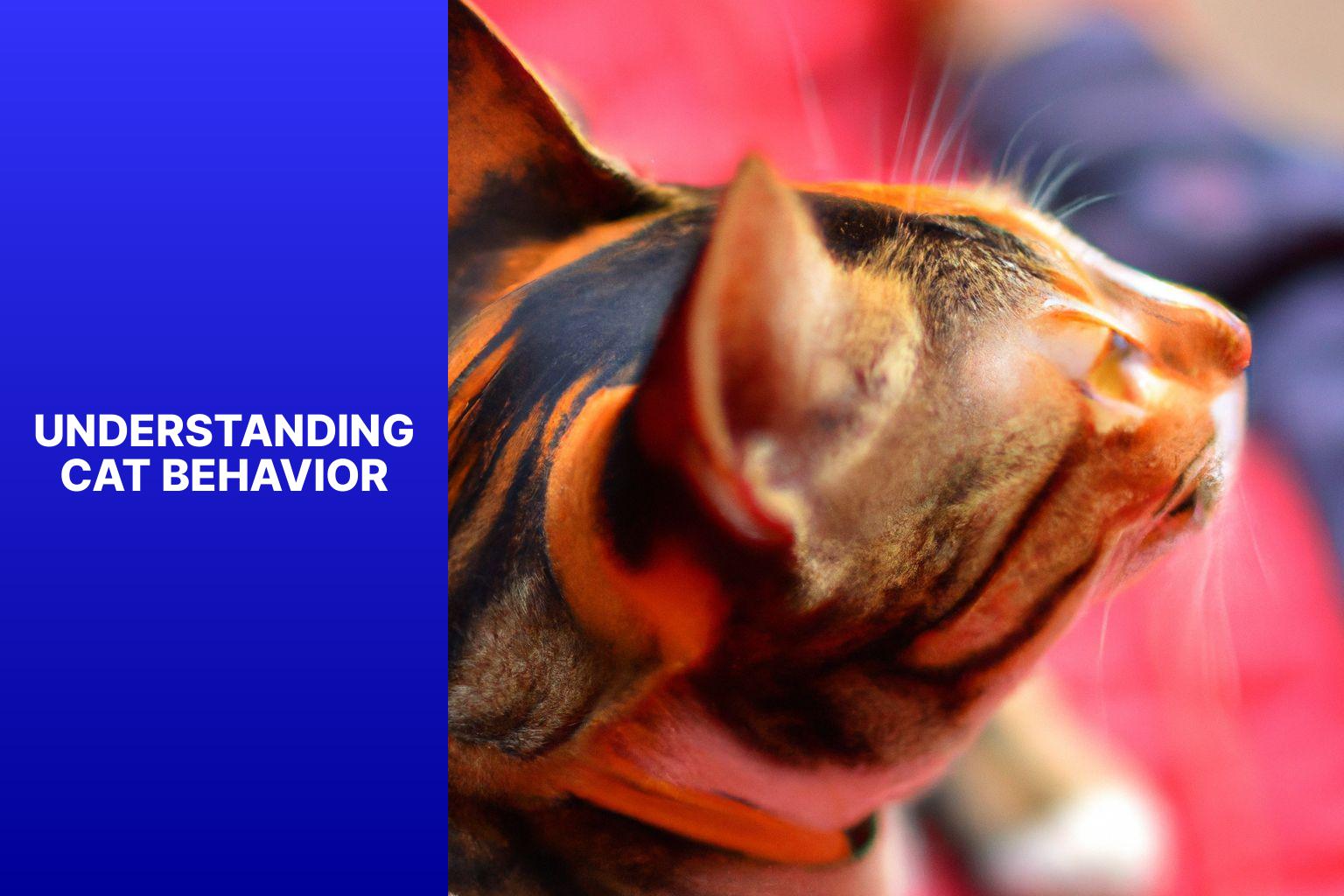Why does my cat walk on me? Understanding cat behavior is key to unraveling this common feline habit. Cats are known for their independent nature and intriguing behaviors that can sometimes perplex their owners. When it comes to walking on their owners, there are several reasons behind this behavior that can vary from marking territory to seeking attention, displaying affection, or even showing dominance.
1. Marking Territory: Cats have scent glands in their paws, and by walking on you, they are leaving their scent and marking you as their territory.
2. Seeking Attention: Cats may walk on their owners as a way to get attention or to communicate their desire for social interaction.
3. Displaying Affection: Some cats walk on their owners as a display of affection and to establish a close bond.
4. In Search of Comfort: Cats often find comfort in the warmth and presence of their owners, so walking on you could be a way for them to seek physical comfort.
5. Showing Dominance: In some cases, cats may walk on their owners as a way to assert their dominance over them.
If you find your cat’s behavior of walking on you bothersome, there are tips to address and manage it. Providing alternative spaces like a comfortable bed or a designated area for your cat can redirect their attention. Establishing boundaries and training them to respect personal space is essential. Positive reinforcement techniques can be used to reward good behavior and discourage walking on you. Engaging in interactive play sessions can help burn off excess energy and prevent attention-seeking behaviors. Understanding your cat’s behavior and using appropriate strategies can help create a harmonious relationship with your feline friend.
Key takeaway:
- Cats walk on their owners to mark territory: Walking on their owners is a way for cats to establish their territory and leave their scent behind.
- Cats walk on their owners to seek attention: By walking on you, cats may be trying to get your attention and engage with you.
- Cats walk on their owners to display affection: Walking on their owners can be a sign of affection, as cats may want to be close to their favorite humans.
Why Does My Cat Walk on Me?
Cats walk on their owners for various reasons. Why does my cat walk on me? First, it may be a sign of affection or attention-seeking behavior. They want to be close to you. Second, cats have a natural instinct to explore and mark their territory, so walking on you is their way of investigating. They find comfort in the warmth and softness of your body. Walking on you can be a way for cats to assert dominance and establish their presence in their territory.
To address this behavior, provide your cat with alternative ways to seek attention and affection, such as interactive playtime and designated spots like a comfortable bed or scratching post. Gently redirect your cat to appropriate surfaces when they walk on you to establish clear boundaries. Creating a relaxing environment with plenty of vertical spaces for your cat to explore can also fulfill their need for territory marking. Understanding your cat’s behavior and providing appropriate outlets will help maintain a harmonious relationship between you and your cat.
Understanding Cat Behavior
Photo Credits: Www.Catcornerblog.Com by Sean Smith
Understanding Cat Behavior is crucial for cat owners to ensure their pets’ well-being and establish a strong bond. Cats are territorial animals and mark their territory by rubbing against people, furniture, and walking on their owners. This behavior indicates their comfort and safety. Cats communicate using body language, such as purring, hissing, or meowing, which helps decipher their needs and emotions.
Cats are natural hunters, and engaging in regular playtime activities satisfies their instinctual needs. Interactive play sessions using toys like balls or feather wands can simulate hunting behavior and provide mental and physical stimulation.
Despite their independent nature, cats still require social interaction and companionship. Spending quality time with your cat, providing opportunities for socializing with other animals, and creating an enriching environment with toys and scratching posts can enhance their overall well-being.
I once had a cat named Whiskers who would bring me small toys or leaves as gifts. Initially, I was perplexed by this behavior, but I soon realized she was displaying affection and her hunting instinct. I learned to appreciate her unique way of expressing love and embraced our bond even more. Understanding cat behavior deepens the connection with your feline companion and ensures a happy and fulfilling life for them.
Why Do Cats Walk on Their Owners?
Cats may walk on their owners for various reasons, including marking territory, seeking attention, displaying affection, searching for comfort, and showing dominance. Cats are independent animals but also have social instincts that drive their behavior. When a cat walks on their owner, it can be seen as a bonding experience and a way for the cat to claim ownership.
One reason why cats may walk on their owners is to mark territory. By walking on their owners, cats leave their scent and establish their presence. This behavior can also be a way for cats to seek attention and interact with their owner. Walking on their owners can be a display of affection, as cats often rub against their owners to show love.
Some cats may walk on their owners for comfort and security. They choose to be close to their trusted human in order to feel safe. Walking on their owners can also be a sign of dominance. Cats may do this to assert their authority and establish a hierarchy within the household.
If you find your cat’s walking behavior bothersome, there are strategies to address it. Providing alternative spaces, such as scratching posts or beds, can redirect their attention. It is also important to establish boundaries and teach them to respect personal space.
Using positive reinforcement and rewarding desirable behaviors, as well as engaging in interactive play with your cat, can help redirect their energy and keep them occupied. Understanding the motivations behind your cat’s behavior is key to effectively addressing it.
Reasons Why Cats Walk on Their Owners
Cats have a mysterious way of connecting with their owners, and one intriguing behavior they often exhibit is walking on us. But have you ever wondered why they do that? In this section, we’ll uncover the fascinating reasons behind this feline behavior. From marking their territory to seeking attention, displaying affection to showing dominance, we’ll dive into the various motivations that lead our furry friends to walk on their beloved humans. Get ready to uncover the secrets behind your cat’s seemingly simple yet meaningful actions.
1. Marking Territory
Cats naturally mark their territory by walking on their owners. This behavior is particularly common in unneutered cats.
If you want to address this issue, it’s important to provide alternative spaces for them to mark and scratch.
Additionally, using positive reinforcement can be effective in teaching your cat to stay off certain areas such as countertops or furniture.
Engaging in interactive play with your cat can also redirect their attention and energy away from territorial marking.
Lastlly, regular grooming can help reduce the need for marking.
2. Seeking Attention
When a cat walks on its owner, it is seeking attention. Cats, despite being independent in nature, still crave interaction with their humans. There are several reasons why cats seek attention by walking on their owners:
- Wanting to be petted: Cats may walk on their owners to ask for affection and attention. They enjoy being touched and petted, and walking on their owners initiates this interaction.
- Feeling lonely or bored: Cats are social creatures and can become lonely or bored without enough attention and stimulation. Walking on their owners may be a way for them to express their need for companionship.
- Seeking playtime: Cats are natural hunters and love to play. Walking on their owners can grab their attention and initiate a play session.
- Asserting their presence: Cats may walk on their owners to assert dominance or mark their territory. By being physically close to their humans, they reinforce their bond and show that they consider their owners part of their territory.
Fact: Cats have various ways of seeking attention, and walking on their owners is just one of them.
3. Displaying Affection
Cats display affection by walking on their owners for several reasons. One reason is seeking closeness. Cats walk on their owners to be close to them and feel secure. It is also a way for cats to bond and show trust and love. Another reason is attention-seeking. Cats walk on their owners to get attention and affection. Cats seek warmth by walking on their owners for temperature regulation. They also display affection by grooming and marking their owners.
To deal with excessive walking behavior, it is important to provide alternative spaces for relaxation. This will help establish boundaries and fulfill the cat’s energy needs. Using positive reinforcement and engaging in interactive play sessions is also beneficial.
4. In Search of Comfort
When a cat walks on its owner, it may be in search of comfort. Here are some reasons for this behavior:
- Seeking warmth: Cats are naturally drawn to warm spots, and your body heat can provide that.
- Security: Cats seek comfort and safety, and being close to their owner can provide a sense of security and reassurance.
- Bonding: Walking on their owner can be a way for cats to bond and show affection. They enjoy being close and engaging in physical contact.
- Stress relief: Some cats find comfort by being near their owner, especially when feeling stressed or anxious. Being close to you can help them feel calm and relaxed.
- Familiarity: Your scent and presence can be familiar and comforting to your cat, so they may choose to walk on you as a way to feel more at ease.
To deal with a cat that walks on you, consider these suggestions:
- Provide alternative spaces: Set up comfortable and cozy spots around your home where your cat can relax and feel secure.
- Establish boundaries: Teach your cat appropriate behaviors by gently redirecting them to their own designated areas, such as a cat bed or scratching post.
- Use positive reinforcement: Reward your cat with treats or praise when they choose to rest in their designated areas instead of walking on you.
- Engage in interactive play: Regularly play with your cat to provide mental and physical stimulation, helping them expend energy and potentially reducing attention-seeking behaviors.
By understanding your cat’s behavior and implementing these strategies, you can create a comfortable and harmonious environment for both you and your feline companion.
5. Showing Dominance
When a cat walks on its owner, it is a way of showing dominance. Cats have a natural instinct to establish territory and assert their dominance. There are several factors to consider in understanding why cats display this behavior:
- Confidence: Cats that walk on their owners are confident and comfortable in their environment.
- Physical contact: By walking on their owners, cats establish physical contact and claim them as their territory.
- Height advantage: When cats walk on their owners, they gain a higher vantage point, giving them a sense of power and control.
- Territorial behavior: Walking on their owners is a way for cats to reinforce their position within their territory.
- Establishing boundaries: Cats use dominance to set boundaries and maintain order within their social hierarchy.
Understanding why cats show dominance can help owners establish a harmonious relationship with their pets. By providing a balanced environment where cats feel secure and respected, while also setting appropriate boundaries, owners can ensure a healthy and respectful dynamic between them and their feline companions.
Tips for Dealing with a Cat that Walks on You
Tired of your cat treating you like a human trampoline? We’ve got you covered with some helpful tips on how to handle a cat that loves to walk all over you. From providing alternative spaces to setting boundaries and using positive reinforcement, we’ll show you strategies that will have your feline friend showing a little more respect. Plus, we’ll dive into the power of interactive play and how it can redirect your cat’s attention away from using you as their personal catwalk. Get ready to take charge and regain your personal space!
1. Provide Alternative Spaces
When your cat walks on you, it may be seeking alternative spaces. Here are some suggestions to provide alternative spaces for your cat:
1. Create a cozy cat bed in a quiet area where your cat can retreat to.
2. Set up a cat tree or perching shelf for your cat to observe from a higher vantage point.
3. Provide hiding spots like covered crates or boxes filled with soft bedding.
4. Designate a sunny windowsill with a comfortable cushion for your cat to bask in the sunlight.
5. Consider installing cat shelves or cat-friendly furniture for vertical exploration.
6. Allocate a separate room or area where your cat can have privacy and escape from disturbances.
By providing these alternative spaces, you give your cat options for relaxation, observation, and solitude. Observe your cat’s preferences and adjust the spaces accordingly to meet its needs.
2. Establish Boundaries
Edited
2. Establish Boundaries
Establishing boundaries is important when dealing with a cat that walks on you. Here are steps to help you establish boundaries:
1. Provide designated spaces for your cat. Set up comfortable beds or cozy corners where your cat can rest and feel secure. This gives them an alternative space instead of walking on you.
2. Use positive reinforcement techniques. Reward your cat when they choose to stay in their designated areas instead of walking on you. This can be done through treats, praise, or playtime.
3. Redirect their attention. Gently guide your cat to their designated areas or distract them with toys or interactive play when you notice them approaching you.
4. Be consistent with your boundaries. Cats thrive on routine, so consistently enforce the boundaries you have set. This will help them understand expected behavior.
5. Respect your cat’s personal space. Just like humans, cats also need alone time. Allow them to have uninterrupted time to themselves.
6. Ensure a comfortable environment. Make sure your cat has access to nearby food, water, and litter boxes in their designated areas. This will further encourage them to stay in those spaces.
By following these steps and being patient, you can establish clear boundaries with your cat and minimize their tendency to walk on you. Remember, consistency and positive reinforcement are key to reshaping their behavior.
3. Use Positive Reinforcement
Positive reinforcement is a highly effective and humane approach to encouraging desired behavior in cats. To implement this technique, it is recommended to reward your cat with treats or praises when they display positive behavior, such as sitting calmly instead of walking on you.
Clicker training can also be a helpful tool in this process. By using a clicker and immediately rewarding your cat when they choose to stay off of you, you can reinforce this desired behavior. Another strategy is to redirect their attention to a toy or scratching post whenever they start walking on you, and reward them for engaging with those alternatives.
Consistency is crucial for success. It is essential to reward your cat every time they exhibit the desired behavior to create a positive association with it. It is important to note that punishing or scolding your cat for walking on you should be avoided, as it can instill fear or aggression.
Patience and persistence are key as it may take time for your cat to consistently exhibit the desired behavior. Creating a positive and enriching environment for your cat can help reduce their need to walk on you for attention or stimulation.
4. Engage in Interactive Play
Engaging in interactive play is essential to ensuring the well-being of your cat. It not only redirects their behavior but also provides them with mental and physical stimulation. To engage in interactive play, follow these simple steps:
1. Choose safe toys: When playing with your cat, make sure to select interactive wands or puzzle toys that are specifically designed for cats. These types of toys will keep them entertained and engaged.
2. Set regular playtime: It is important to establish a routine by scheduling daily play sessions at the same time. This will help your cat understand when playtime is and look forward to it.
3. Use enticing movements: To keep your cat engaged, it is important to mimic prey behavior with the toys. Cats are natural hunters, so using enticing movements will activate their instinct to chase and pounce.
4. Encourage chasing and pouncing: Let your cat simulate hunting by allowing them to chase and pounce on the toys. This will fulfill their natural hunting instincts and provide them with both mental and physical exercise.
5. Provide rewards: Reinforce positive behavior during playtime by providing treats or praise. This will encourage your cat to continue engaging in interactive play and make it a positive experience for them.
6. Rotate toys: Prevent boredom by regularly changing the toys that you use during playtime. Cats can easily get bored with the same toys, so switching them up will keep them interested and excited.
7. Monitor playtime: It is important to supervise your cat during playtime to ensure their safety and prevent any aggression. Keep an eye on their behavior and intervene if necessary.
Lily, a playful tabby cat, used to demand attention by walking on her owner, Sam. To address this, Sam started engaging in interactive play with Lily using a feather wand toy. They would play for 10 minutes every evening before dinner. Over time, Lily’s behavior improved, and she started walking on Sam less frequently. Interactive play not only redirected Lily’s attention but also strengthened the bond between Sam and Lily, creating a harmonious home environment.
Some Facts About Why Cats Walk on Their Owners:
- ✅ Cats may walk on their owners as a way to show affection and love, and to feel safe and secure. (Source: Purrpetrators)
- ✅ Cats may also walk on their owners to make a bed and find a warm and soft place to rest. (Source: Purrpetrators)
- ✅ Cats may walk on their owners to grab their attention and divert focus from work or other activities. (Source: Purrpetrators)
- ✅ Some people believe that cats walk on their owners to mark their territory and assert dominance. (Source: Purrpetrators)
- ✅ Cats may also walk on their owners to get attention and warmth. (Source: Excited Cats)



